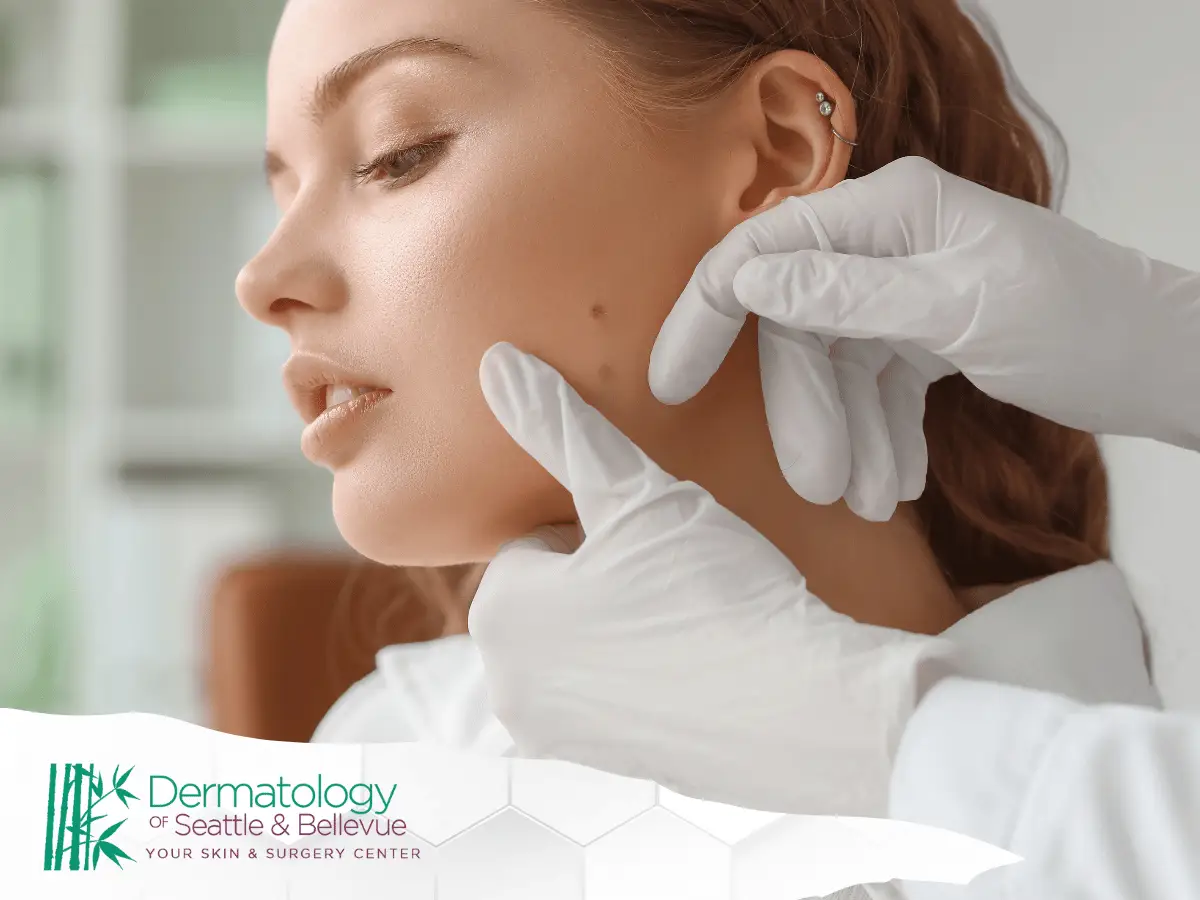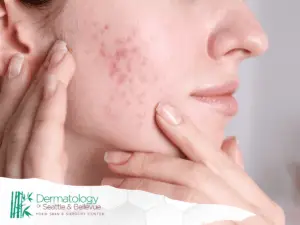Noticing a mole that itches or bleeds can be alarming. While not every change in a mole means you have cancer, it’s important to understand when these symptoms could point to something more serious—like melanoma skin cancer. Knowing the signs to watch for can help you take action early and protect your skin health.
Quick Summary
- Itchy or bleeding moles are not always cancer, but persistent symptoms or sudden changes can signal melanoma and should be evaluated.
- Use the ABCDE rule to spot concerning moles: asymmetry, irregular borders, multiple/uneven colors, diameter over ~6mm, and evolving changes including itching or bleeding.
- Itching can come from dry skin, irritation, friction, or conditions like eczema/psoriasis, but is more concerning when paired with bleeding, scaling, rapid growth, or other ABCDE changes.
- Bleeding is especially concerning when it happens spontaneously, recurs, or is accompanied by scabbing/ulceration and changes in size, color, or edges.
- Risk increases with UV exposure (sunburns, tanning beds), family history, and fair/freckled skin; do monthly self-checks (including scalp, nails, soles) and see a dermatologist for suspicious or changing moles.
This blog will break down the symptoms, risk factors, and when you should talk to a doctor about a problematic mole. We’ll also explore treatment options and how to stay proactive with your skin care routine.
Signs of potential skin cancer in moles
A healthy mole typically remains unchanged for years. But if it starts shifting in size, shape, or color, it may be a cause for concern. These changes could indicate a developing melanoma, a dangerous form of skin cancer that often starts in existing moles.
Understanding the signs of melanoma can help you catch problems early. Dermatologists rely on the ABCDE rule when evaluating moles:
- Asymmetry: One half of the mole doesn’t match the other
- Border: Edges are irregular, notched, or blurred
- Color: Includes multiple shades or uneven coloring
- Diameter: Larger than a pencil eraser (about 6mm)
- Evolving: Any change in size, shape, color, or symptoms like itching or bleeding
Even one of these signs can be a red flag, especially when paired with new symptoms like itchiness or discomfort.
Changes in mole size
One of the earliest warning signs of melanoma is a change in size. If a mole grows noticeably larger over weeks or months, it’s something that shouldn’t be ignored. This can sometimes happen slowly, making it harder to detect without regular skin checks.
- Small moles that expand may cross the line from benign to suspicious
- Monitoring with photos (yes, even simple pictures on your phone) can help track changes
- Dermatology professionals can assess whether a growing mole requires biopsy or removal
Although not all enlarging moles are melanoma, any noticeable size increase should be evaluated by a doctor.
Irregular borders of moles
A normal mole typically has smooth, clearly defined edges. When a mole begins to develop irregular borders, it could signal early melanoma. Jagged, scalloped, or blurred lines around a mole may suggest that abnormal skin cells are spreading.
This uneven growth can also lead to asymmetry, another visual clue that something could be wrong. If one side of the mole doesn’t match the other or the shape changes over time, it’s worth having a dermatologist take a closer look. Border irregularity is especially important when combined with other symptoms like itching or bleeding.
Variation in color of moles
Moles that are uniform in color—typically brown—are generally harmless. But when you notice a variation in color, such as dark spots, pink areas, black patches, or even shades of blue, that mole may be showing signs of cancerous changes. Additionally, if the mole has an irregular shape or its edges are blurred, these can also be signs of a cancerous mole. It’s crucial to monitor any changes in size, symmetry, or texture, as these alterations could indicate a risk for skin cancer. Regular self-examinations and consultations with a dermatologist can help in the early detection of these concerning signs.
Melanoma skin cancer can often appear as a multicolored or unevenly pigmented lesion. A sudden shift in the color of a mole, especially if it develops red, black, or white areas, should prompt an immediate checkup with a skin specialist.
Itching as a potential symptom
It’s easy to overlook itchiness—especially when it comes from a mole. But when a mole itches persistently, it could be more than just a minor irritation. While itchiness doesn’t always mean cancer, it may be one of the early symptoms associated with changes in the skin’s cellular structure.
Understanding the cause of the itch is key. From certain skin care products to underlying problems like psoriasis or eczema, not all itching is dangerous. However, if it continues or gets worse—especially alongside a bleeding mole—it becomes a clear cause for concern.
Causes of itching in moles
An itchy mole doesn’t always point to melanoma. There are several benign reasons a mole may start to itch, especially when external factors irritate the skin.
Common non-cancerous causes include:
- Dry skin, particularly in winter or after sun exposure
- Allergic reactions to skincare ingredients or certain skin care products
- Chafing or friction from clothing or accessories
- Underlying dermatology conditions like eczema, psoriasis, or rosacea
Still, any new or worsening itchiness—especially in a previously stable mole—warrants attention, particularly if it comes with color changes or discomfort.
When itching could be a sign of concern
Persistent or worsening itchiness should never be dismissed outright. When a mole itches, it could indicate abnormal cellular activity beneath the skin, possibly linked to cancer.
Signs that itching may be more serious include:
- Itchiness paired with bleeding, scaling, or rapid growth
- Discomfort that doesn’t go away with moisturizers or basic skin care
- A mole that has changed in shape, size, or color in addition to itching
If you notice these combined issues, it’s a smart move to book an appointment with a dermatologist. Early detection of melanoma greatly improves treatment outcomes.
Bleeding as a potential symptom
A mole that bleeds is another sign that shouldn’t be ignored—especially if the bleeding starts spontaneously and not from scratching or injury. Bleeding moles may point to damaged or fragile skin tissue, often caused by changes in the mole’s deeper structure.
While not every bleeding mole is cancerous, it is more alarming than itchiness alone. Melanoma skin cancer can sometimes cause a mole to ulcerate or scab, leading to bleeds that won’t heal properly. This makes it one of the more urgent symptoms to monitor.
Causes of bleeding in moles
There are a few possible explanations for a mole that bleeds, and not all of them are dangerous. Sometimes bleeding occurs due to friction, injury, or even picking at the area. For example, a mole on the body might rub against clothing or get scratched during routine grooming.
Other times, dry skin or irritation from skin care products can weaken the surrounding tissue, making the mole more prone to bleeds. But even if there’s a clear external cause, bleeding should not be ignored—especially if it recurs or happens without any pressure or trauma.
When bleeding could indicate skin cancer
Spontaneous bleeding from a mole is a potential warning sign of melanoma. In melanoma skin cancer, a mole may begin to break down from within, creating fragile skin that cracks or oozes. If a mole becomes scabby, ulcerated, or bleeds repeatedly without being touched, it’s time to get it examined.
Bleeding combined with the following should raise red flags:
- A change in size, color, or edges
- Persistent itchiness
- A rough or uneven shape
Seeing a doctor quickly in these cases can make all the difference in catching and treating the problem early.
Risk factors for skin cancer
While anyone can develop skin cancer, certain people face a higher risk. Knowing what increases your vulnerability helps guide your habits and informs how often you should perform skin checks.
Some individuals are more prone to developing melanoma and other forms of cancer due to environmental, genetic, or lifestyle-related reasons. Being aware of these risk factors lets you take proactive steps to protect your health and get early treatment if needed.
Exposure to UV radiation
Excessive sun exposure is the leading environmental risk factor for skin cancer, especially melanoma. Ultraviolet (UV) radiation damages the DNA in skin cells, which can lead to mutations and abnormal growth over time.
This risk is even higher for people who:
- Spend a lot of time outdoors without sunscreen
- Have a history of blistering sunburns, especially in childhood
- Use tanning beds regularly
- Live in sunny or high-altitude regions where UV is stronger
Even on cloudy days, UV rays can harm your skin, so sun protection is a year-round necessity—not just a summer routine.
Family history of skin cancer
Your genes play a key role in your risk for developing skin cancer. If a close relative—like a parent or sibling—has had melanoma, your chances of getting it increase. This inherited risk can be tied to specific genetic mutations that affect how your body repairs DNA damage from UV light.
Even if you’ve never had a suspicious mole or symptoms, a family history should encourage regular screenings. It’s a case where awareness is power: the earlier you catch melanoma, the better the chances for successful treatment.
Fair skin and freckling
People with fair skin, freckles, light-colored eyes, or red or blonde hair are naturally more vulnerable to UV damage. This group tends to have less melanin—the pigment that protects the skin from the sun’s harmful rays.
Those with this skin type should be extra cautious when spending time outside. Even a short amount of sun exposure can raise their lifetime risk for melanoma, making prevention and early detection especially important.
Importance of regular skin checks
Catching skin cancer early gives you the best chance at successful treatment. That’s why regular skin checks—both at home and with a dermatologist—are a critical part of skin health maintenance. Many people only notice a mole once it becomes uncomfortable or visible, but by that point, serious changes could already be underway. Incorporating mole checks for skin cancer into your routine can help you identify any unusual changes early on. It’s important to familiarize yourself with the appearance of your moles, as this awareness can make a significant difference in your detection efforts. Regular consultations with a dermatologist can further enhance your ability to spot potential issues before they escalate.
Early signs of melanoma can be subtle, so having a routine in place makes it easier to notice new or evolving dark spots, bleeding moles, or itchiness before they become advanced. If you’re unsure about what to look for, a skin exam with a professional can provide clarity and peace of mind.
Self-examination tips
Doing monthly skin checks at home helps you stay in tune with your body and spot changes before they become major problems. Use a full-length mirror in a well-lit room, and don’t forget to examine less visible areas like your scalp, back, nails, and soles of your feet.
Look for:
- New moles or spots that weren’t there before
- Existing moles that are changing in size, shape, or color
- Any mole that itches or bleeds without clear cause
- Nail discoloration or pigment lines, which can indicate subungual melanoma
Documenting your findings with photos can help you track changes more accurately over time.
When to see a dermatologist
If you notice a mole that doesn’t look right—or if it starts to itch, bleed, or change rapidly—don’t wait. Schedule a visit with a dermatologist as soon as possible. Even if it turns out to be nothing, a professional opinion can ease your concern and provide guidance.
You should also seek an expert evaluation if:
- You have a family history of melanoma
- You’ve had multiple sunburns or use tanning beds
- You have over 50 moles or atypical moles
Many patients also ask about mole removal if a spot is irritating or cosmetically unwanted, but the priority is always determining whether there’s a medical cause for concern.
Treatment options for skin cancer
If a mole is diagnosed as melanoma or another type of skin cancer, timely treatment is essential. Fortunately, medical advancements have improved outcomes significantly, especially when the cancer is caught early.
The treatment plan depends on several factors, including:
- The type and stage of cancer
- The location and size of the mole
- The patient’s overall health and history
Dermatology specialists may use a combination of therapies to ensure all cancerous cells are eliminated and to prevent recurrence.
Surgical removal
Surgical removal is the most common and often most effective method of treating localized melanoma. This procedure involves excising the mole and a margin of healthy skin to make sure no cancerous cells remain. In many cases, this is all that’s needed.
Benefits of surgery include:
- High success rates for early-stage melanoma
- Quick recovery for small lesions
- Minimal scarring when done by a skilled provider
If biologic therapy or further evaluation is needed, your provider will discuss next steps.
Radiation therapy
When melanoma skin cancer has spread or can’t be fully removed with surgery, radiation therapy may be recommended. This treatment uses focused energy to destroy cancer cells in specific areas of the body.
It’s often used in conjunction with other therapies, especially when lymph nodes are involved. Side effects vary depending on the treatment site but are usually manageable with proper care and follow-up.
Chemotherapy
Chemotherapy is less common for melanoma than other cancers, but it can still be part of the plan for advanced cases. It involves using drugs to kill rapidly dividing cancer cells throughout the body, especially when the disease has spread to distant organs.
In modern dermatology, systemic therapies like biologics and immunotherapy are often favored over traditional chemotherapy for melanoma, but the approach depends on the individual patient’s condition and response to previous treatments.
Preventative measures
Preventing skin cancer starts with protecting your skin from the sun and being proactive about changes. Small daily habits can have a big impact over time, especially if you’re already at risk.
Even if you’ve never had a problem mole, prevention is key to long-term skin health. This includes avoiding tanning beds, staying in the shade, and using skin care products that support your routine without irritation.
Importance of sunscreen
Using sunscreen daily is one of the most effective ways to prevent melanoma and other forms of skin cancer. Even in the winter or on cloudy days, UV radiation can damage unprotected skin.
Here’s what to look for:
- SPF 30 or higher with broad-spectrum protection
- Water-resistant formulas for extended outdoor activity
- Reapplication every 2 hours or after swimming/sweating
- Fragrance-free options for sensitive skin
Sunscreen should be applied to all exposed areas—including the ears, nail beds, and neck—places where cancer can also develop.
Protective clothing and accessories
In addition to sunscreen, physical protection goes a long way in shielding your skin from UV rays. This is especially helpful for those with fair skin, a large number of moles, or a family history of skin cancer.
Smart protective measures include:
- Wearing wide-brimmed hats and UV-blocking sunglasses
- Choosing long sleeves and pants made from sun-protective fabrics
- Staying under shade during peak sun hours (10 a.m. to 4 p.m.)
- Using umbrellas or seeking cover when outdoors for extended periods
Final thoughts and recommendations
So—if a mole itches or bleeds, does that mean it’s skin cancer? Not always, but it’s definitely a signal to pay attention. While not every change is melanoma, unusual symptoms like itchiness, bleeding, or irregular shape and color should never be ignored.
Whether you’re dealing with a new dark spot, an irritated mole, or just questions about skin care, the best approach is staying informed and proactive. Don’t hesitate to reach out to a dermatologist if something seems off.
Your health is worth the check.





